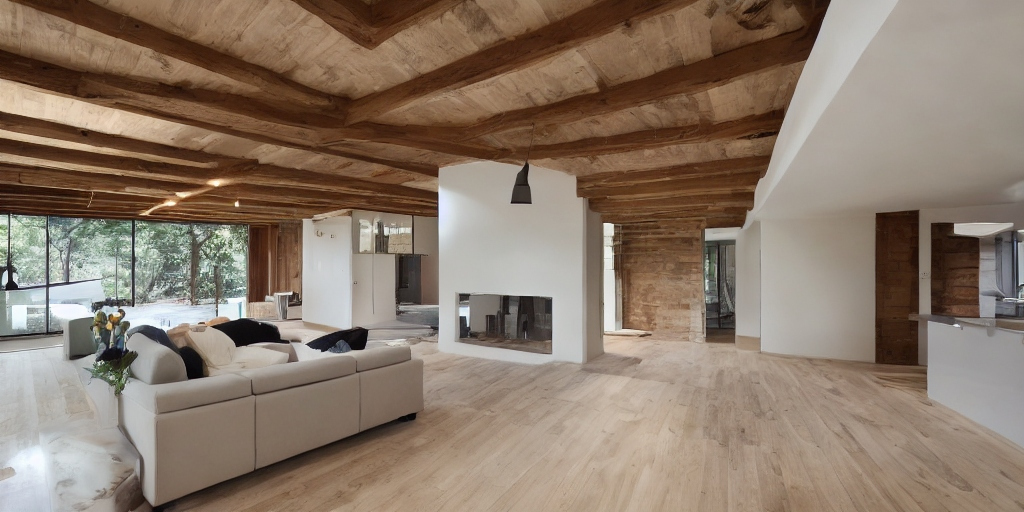In the vibrant world of interior design, renovation isn’t just about making a space look appealing. It’s a delicate art of blending aesthetics with functionality, creating a haven that reflects one’s personality and lifestyle. Whether it’s a quaint little cottage or a sprawling mansion, every home tells a story, and it’s the interior that sets the stage.
With the growing trend of DIY projects and a myriad of design inspirations available online, homeowners are now more empowered than ever to take on interior renovation projects. However, the process can be overwhelming, with countless design choices, budget constraints, and potential pitfalls.
This article seeks to navigate the labyrinth of interior renovation, providing insightful tips and expert advice to transform your space without breaking the bank. So, buckle up and get ready to embark on a journey of creativity and discovery that will redefine your living space.
Understanding Interior Renovation
Interior renovation, in essence, involves transforming an existing space to enhance its aesthetic appeal, functionality, and safety. Thoughtfully executed, it amplifies the comfort, satisfactions and overall charisma of one’s domicile.
Recognizing Forms of Interior Renovation offers insights into the breadth of this home improvement domain. Different types include structural changes (e.g., removing or adding walls), cosmetic alterations (e.g., painting, wallpapering), and updates to installed fixtures (e.g., cabinetry, plumbing).
Knowledge About the Process provides a comprehensive understanding of the steps involved. An outline encompasses designing, planning, demolition (if necessary), construction, and final touches such as painting and furnishing.
Undergoing an Interior Renovation Demands Professional Guidance, despite the rise in DIY renovation projects as professional help ensures safety, regulatory approvals, and quality outcomes. A professional team consists of architects, interior designers, contractors, and sub-contractors, each playing a crucial role.
Aside from aesthetic considerations, Optimal Functionality and Safety are primary concerns during renovations. This involves proper space planning, enhancing natural lighting, improving energy efficiency and ensuring fire safety measures.
In addition to this, Understanding Costs is indispensable. Various factors influencing the total cost encompass labor, materials, size of space, level of complexity, and one’s location.

Lastly, considering Time-frames for Completion assists homeowners load realistic expectations. This encompasses planning, obtaining permissions, sourcing materials, and completing the actual renovation work.
Remember, interior renovation isn’t merely about the physical change in structure or appearance. It’s an opportunity to create a nurturing environment that aligns with one’s lifestyle and personifies their unique tastes.
Planning Your Interior Renovation
Renovating a home’s interior poses challenges but also opportunities to enhance its aesthetic and functionality. The planning phase constitutes an integral part of this process. A well-laid plan eliminates potential roadblocks, reduces costs, and ensures the renovated home meets the homeowner’s vision.
First and foremost, define the renovation’s purpose. Are the changes cosmetic, structural, or perhaps a combination of both? The purpose directs what occurs next in the planning process, dictating how much time, money, and effort go into the renovation. For instance, simple cosmetic changes, such as repainting or changing the furniture, demand less time and resources than structural modifications.
Budget allocation represents an essential step. Renovations require considerable funding, even for minor modifications. It’s prudent to estimate the cost beforehand and prepare a detailed budget that includes materials, labor, and additional expenses. A contingency fund, set aside for unexpected costs, proves a clever addition to the budget.
Consider the project’s timeline next. Both small-scale cosmetic changes and extensive structural renovations require time. Homeowners can personalize detailed schedules, taking into consideration their availability and any potential disruptions to daily life.
Homeowners must analyze local regulations too. Some areas dictate what remodeling homeowners can carry out and require permits for certain types of projects. A thorough understanding of these rules prevents potential violations.
Lastly, deciding whether to hire professionals or tackle the project DIY-style is an important consideration. Homeowners must assess their skills and time commitment accurately before deciding. While DIY projects can save money, they can prove challenging and time-consuming. Meanwhile, professionals bring experience and skills to the project, ensuring a smooth renovation process.
Taken together, planning a renovation remains an intricate process with various vital elements. By considering purpose, budget, timeline, local regulations, and whether to hire professionals or go DIY, homeowners pave the way to a successful renovation. Remember, meticulous planning results in smooth execution, helping transform a house into a dream home.
Hiring the Right Professionals for Interior Renovation
Interior renovation, including structural and cosmetic changes, pertains to the homeowners’ desire for a space that reflects their unique style. While DIY projects might be appealing due to their potential cost savings and hands-on experience, professional guidance offers the added advantage of expertise and experience.
Finding the right professional for one’s renovation needs is imperative. Homeowners need to consider several factors before hiring the ideal candidate, starting with their qualifications. These include experiences and any relevant certifications that show they possess the required skills. For example, qualified building contractors often hold relevant degrees, certifications, and notable portfolios highlighting their previous projects.
Comparisons between potential professionals also aid in the selection process. Homeowners can compare factors like pricing rates, reputation, testimonials, and work portfolios of multiple contractors. These comparative analyses offer a peek into each contractor’s work ethics and their ability to meet project expectations.
Communicating the renovation expectations to potential professionals is a vital step. Pinpointing their thoughts on your renovation ideas, budget, and set timeframe helps to analyze their responsiveness and willingness to cater to your specific needs.
The size and complexity of the renovation project dictate the kind of professional one requires. Small-scale renovations might involve hiring an interior designer or a decorator. However, for large scale renovations, assembling a team of professionals, which might include a general contractor, architect, and interior designer can more effectively execute a larger vision.
Partnering with professionals does not diminish the homeowner’s role in the renovation. They maintain a hands-on approach, making final decisions and giving approvals during the entire renovation process. This scenario ensures the homeowner stays engaged, allowing the professionals to bring the homeowners’ vision to life.
Hiring the right professional often involves comprehensive research, communication, and some level of involvement from homeowners. A well-chosen professional ensures efficient project execution, reduces stress, and guarantees that the end result aligns with the homeowner’s vision and expectations. Remember, meticulous planning and careful selection of professional assistance can transform any space to mirror the lifestyle and preferences of the owner without violating local regulations or going over budget.

Cost Factors of Interior Renovation
Cost is a significant facet of interior renovation. It does not revolve around labor and material costs alone. It encompasses a wider spectrum, influenced by variegated factors. For instance, the scale of the project, the materials used, labor costs, timeline, and location can lead to a ripple effect in the overall cost. Each of these parameters can notably affect the budget and require an in-depth analysis.
Size of the Project
The overall area for renovation undeniably affects the cost factor. It’s reasonable that larger scale renovations, encompassing entire homes or multiple rooms, will cost significantly more than focusing on a single room. Despite this, it’s essential to remember even minor alterations in smaller spaces may bear hefty price tags, if high-end materials or intricate installations are called for.
Materials Used
Renovation costs feel the impact of the choice of materials and their quality. High-grade materials, such as marble countertops or bamboo flooring, demand more considerable investments compared to their more cost-effective counterparts. In some instances, homeowners opt for sustainable materials, adding another layer to the cost structure, given their ecological and economic benefits.
Labor Costs
The price tag of skilled labor forms a substantial portion of a renovation budget. It varies based on the choice of professionals, their hourly rates, and the project’s complexity. Additionally, unforeseen problems that arise during the renovation may necessitate additional labor, thereby escalating costs.
Timeline
The total cost correlates directly with the project timeline. Extensions in the project schedule often mean an increase in labor and potentially material costs. More efficient planning can help minimize delays and avoid these additional expenses.
Location
Geographical location dictates the costs of both labor and materials. Renovations can be more expensive in areas with higher living costs. Furthermore, local regulation compliance and permitting costs can influence the overall budget of an interior renovation project.
By keenly factoring in all these variables, homeowners stand a better chance of steering clear of budget overruns, helping ensure the financial success of a renovation project.
Popular Interior Renovation Trends
Proactive homeowners stay updated with contemporary interior renovation trends. These popular remodeling styles optimize home value, boost aesthetics and enhance functionality.
Open Space Concept: Erasing barriers and creating a seamless flowing space constitutes the open space concept. An instance of this trend includes integrating the living room, dining area, and kitchen into one unified space. This layout guarantees light floods the room, producing an inviting ambiance.
Sustainable Designs: The growing consciousness about our environment has influenced interior renovation trends. Efforts to promote sustainability include the use of renewable and recyclable materials like bamboo and cork. Proponents also select energy-efficient appliances, products with less off-gassing, and water-saving plumbing fixtures.
Smart Home Technology: Aspects of dwelling convenience, security, and energy efficiency are transformed by smart home technology. Examples include programming lighting to match activity schedules or remote thermostat control. Homeowners also option for smart security systems, giving them peace of mind.
Natural Elements: The drive to embrace nature within residential spaces exemplifies another trend. Stone wall finishes, indoor plants, wooden furniture, or even water features bring an organic, calming aura.
Multifunctional Spaces: With reduced home sizes and remote working, multifunctional spaces are becoming necessary. An area can double as a work-at-home office during the day and a family recreational room in the evening.
Minimalist Designs: Simplicity and functionality underpin minimalist designs. This trend eliminates clutter, uses a neutral color scheme, and selects furnishings that fulfill multiple purposes.
Undertaking a renovation is no small feat. Given its complexity, homeowners must carefully understand and incorporate these popular interior renovation trends. These trends strike a balance between aesthetic enhancement, space utilization, environmental friendliness, and technology embracement, marking the path to the successful home makeover. The homeowner can provide specific requirements to the professional involved, ensuring the renovated space closely aligns with their personal style, lifestyle, and renovation budget previously established.
Managing Your Renovation Project
Managing a renovation project constitutes numerous elements such as creating a realistic timeline, carefully tracking budget, practicing effective communication with your team, and handling unexpected issues swiftly and efficiently. All these factors are critical in ensuring a smooth and successful renovation project.
Establishing a Realistic Project Timeline is primary. Consider the scope and complexity of your project, and establish a timeline with your contractor. Account for potential delays, especially if the renovation involves structural changes. For instance, a comprehensive kitchen makeover, involving plumbing, electrical work, and cabinet installation, typically takes around eight weeks.
Budget Tracking is a requirement for financial control. Note financial considerations from the get-go and maintain strict budget tracking throughout the project. Tools like home renovation apps could be useful for this purpose. For example, applications such as HomeZada and Mendr offer comprehensive budget tracking features.
Effective Team Communication proves vital. Regular meetings with your contractor, designer, and other team members ensure everyone stays on the same page. Constructive and open communication helps preempt miscommunication and confusion, thereby contributing to a more streamlined project execution.
Unexpected Issue Management calls for adaptability. With renovations, unexpected issues such as discovering structural problems once the project starts are a frequent occurrence. Being adaptable and proactive when such situations arise aids in preventing major issues down the line.
Lastly, be informed and actively participate in the project. This doesn’t mean micromanaging every facet of the renovation, rather demonstrating interest and involvement to ensure that the project aligns with your vision.
Following this approach, equipped with proper planning, clear communication, and adaptability, homeowners can successfully manage their renovation projects, securing the dream interior renovation that suits their style and budget.
Renovating your home’s interior is more than just a change of scenery. It’s a chance to express your personal style and adapt your space to your lifestyle. The key to a successful renovation lies in careful planning and hiring the right professionals. It’s vital to manage the project efficiently, keeping track of the budget and timeline while maintaining open communication with your team. Embracing tools like home renovation apps can streamline this process. Remember, it’s your vision that guides the project, so don’t hesitate to actively participate. With these steps in mind, you’re well on your way to achieving an interior renovation that not only suits your style but also stays within your budget.





